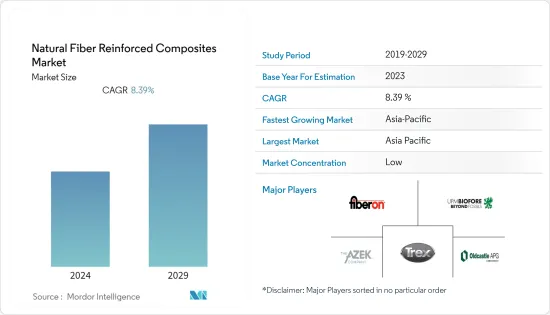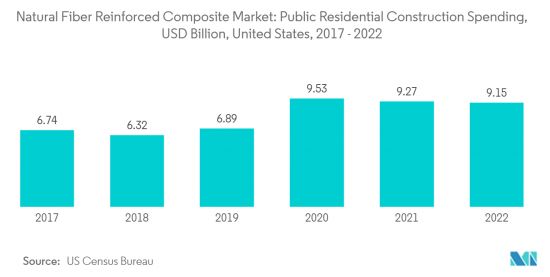Need help finding what you are looking for?
Contact Us
PUBLISHER: Mordor Intelligence | PRODUCT CODE: 1403978

PUBLISHER: Mordor Intelligence | PRODUCT CODE: 1403978
Natural Fiber Reinforced Composites - Market Share Analysis, Industry Trends & Statistics, Growth Forecasts 2024 - 2029
PUBLISHED:
PAGES: 125 Pages
DELIVERY TIME: 2-3 business days
SELECT AN OPTION

The natural fiber reinforced composites market is expected to grow from 4,081.05 kilo tons in 2024 to 6,104.85 kilo tons by 2029, registering a CAGR of 8.39% during the forecast period.
Key Highlights
- Over the medium term, factors such as the increasing demand for bio-based composites and the growing demand for eco-friendly composites in the electronics industry would drive the natural fiber-reinforced composites market.
- However, the moisture adsorption, restricted processing temperature, incompatibility with most polymer matrices, and lower impact resistivity compared to glass fiber-reinforced composites are likely to act as restraints for the market.
- Nevertheless, the flame retardancy of natural fiber-reinforced polymer composites is expected to provide new opportunities for the market.
- The Asia-Pacific region dominates the market and is likely to witness the highest CAGR during the forecast period. This growth is attributed to the rapid rise in expenditure on the construction industry.
Natural Fiber Reinforced Composites Market Trends
Increasing Demand from the Construction Sector
- There is always a continuous requirement for eco-friendly materials in the building materials industry. Natural fiber-reinforced polymer-based composites are increasingly used in civil engineering construction applications due to their numerous advantages.
- In the building and construction industry, composite materials are extremely significant. Industrial supports, tanks, long-span roof structures, tanks, high-rise buildings and lightweight doors, windows, furnishings, lightweight buildings, bridge components, and complete bridge systems have all employed composite materials. Composite materials are becoming increasingly essential in the construction industry as a means of achieving long-term sustainability.
- The construction sector has witnessed major investments in recent years. According to Oxford Economics, the global construction industry is expected to grow by USD 4.5 trillion, or 42%, between 2020 and 2030 to reach USD 15.2 trillion. Also, China, India, the United States, and Indonesia are expected to account for 58.3% of global growth in construction between 2020 and 2030.
- In North America, the United States has a major share in the construction industry. Besides the United States, Canada and Mexico contribute significantly to investments in the construction sector. According to the United States Census Bureau Data, the annual value of public residential construction in the United States was valued at USD 9.15 billion in 2022, an increase of 35.7% compared to USD 6.74 billion in 2017.
- Similarly, the European construction sector grew by 2.5% in 2022 due to new investments from the EU Recovery Fund. Business confidence picked up in early 2022, despite price pressures at most EU construction firms, and is expected to reach pre-COVID-19 levels. Moreover, as the crisis due to COVID-19 abates, builders become less reluctant to invest in new corporate buildings and renovate existing properties.
- Hence, the aforementioned trends are projected to influence the growth of natural fiber-reinforced composites in the construction sector over the forecast period.

Asia-Pacific Region to Dominate the Market
- The Asia-Pacific region is expected to dominate the global market. With growing construction activities in countries such as China, India, and Japan, the usage of natural fiber-reinforced composites is increasing in the region.
- The construction sector is a key player in China's continued economic development. According to the National Bureau of Statistics of China, the value of construction output accounted for CNY 31.2 trillion (USD 4.5 trillion) in 2022, up from CNY 29.3 trillion (USD 4.2 trillion) in 2021. China is expected to spend nearly USD 13 trillion on buildings by 2030, creating a positive outlook for natural fiber-reinforced composites.
- As per the Ministry of Housing and Urban-Rural Development, China's construction sector is expected to maintain a 6% share of the country's GDP going into 2025. Keeping in view the given forecasts, the Chinese government unveiled a five-year plan in January 2022 focused on making the construction sector more sustainable and quality-driven.
- Similarly, the surging application of natural fiber-reinforced composites in the electronics industry is likely to support the industry growth in the country. According to the India Brand Equity Foundation (IBEF), the Indian electronics manufacturing industry is expected to reach USD 520 billion by 2025.
- Furthermore, automotive is among the major consumers of natural fiber-reinforced composites. The automotive industry in India is an important indicator of the Indian economic performance, as this sector plays a vital role in both technological advancements and macroeconomic expansion.
- Additionally, the Indian government has created momentum through its Faster Adoption and Manufacturing of (Hybrid and) Electric Vehicles schemes that encourage, and in some segments, mandate the adoption of electric vehicles (EV), intending to reach 30% EV penetration by 2030. The scheme creates demand incentives for EVs and supports the deployment of charging technologies and stations in urban centers. The government has set a target of 70% of all commercial cars, 30% of private cars, 40% of buses, and 80% of two-wheelers and three-wheelers sold in India by 2030 to be electric.
- Hence, the new policies and investments made by different governments are expected to boost the demand for the natural fiber-reinforced composites market in the rest of Asia-Pacific during the forecast period.
Natural Fiber Reinforced Composites Industry Overview
The natural fiber-reinforced composites market is fragmented, with no player capturing a significant market share. The major players in the market (in no particular order) include Trex Company Inc., Fiberon Technologies Inc., UPM-Kymmene Oyj, The AZEK Company, and Oldcastle APG, among others.
Additional Benefits:
- The market estimate (ME) sheet in Excel format
- 3 months of analyst support
Product Code: 54642
TABLE OF CONTENTS
1 INTRODUCTION
- 1.1 Study Assumptions
- 1.2 Scope of the Study
2 RESEARCH METHODOLOGY
3 EXECUTIVE SUMMARY
4 MARKET DYNAMICS
- 4.1 Drivers
- 4.1.1 Increasing Demand for Bio-based Composites
- 4.1.2 Growth in Automotive Industry Worldwide
- 4.2 Restraints
- 4.2.1 Moisture Adsorption, Restricted Processing Temperature, and Incompatibility with Most Polymer Matrices
- 4.2.2 Degradation Issue Due to Exposure to the External Environment
- 4.3 Industry Value Chain Analysis
- 4.4 Porter's Five Forces Analysis
- 4.4.1 Bargaining Power of Suppliers
- 4.4.2 Bargaining Power of Consumers
- 4.4.3 Threat of New Entrants
- 4.4.4 Threat of Substitute Products and Services
- 4.4.5 Degree of Competition
5 MARKET SEGMENTATION (Market Size by Volume)
- 5.1 Fiber
- 5.1.1 Wood Fiber Composites
- 5.1.2 Non-wood Fiber Composites
- 5.1.2.1 Cotton
- 5.1.2.2 Flax
- 5.1.2.3 Kenaf
- 5.1.2.4 Hemp
- 5.1.2.5 Other Non-wood Fiber Composites
- 5.2 Polymer
- 5.2.1 Thermosets
- 5.2.2 Thermoplastics
- 5.2.2.1 Polyethylene
- 5.2.2.2 Polypropylene
- 5.2.2.3 Poly Vinyl Chloride
- 5.2.2.4 Other Thermoplastics
- 5.3 End-user Industry
- 5.3.1 Aerospace
- 5.3.2 Automotive
- 5.3.3 Building and Construction
- 5.3.4 Electrical and Electronics
- 5.3.5 Sports
- 5.3.6 Other End-user Industries
- 5.4 Geography
- 5.4.1 Asia-Pacific
- 5.4.1.1 China
- 5.4.1.2 India
- 5.4.1.3 Japan
- 5.4.1.4 South Korea
- 5.4.1.5 Rest of Asia-Pacific
- 5.4.2 North America
- 5.4.2.1 United States
- 5.4.2.2 Canada
- 5.4.2.3 Mexico
- 5.4.3 Europe
- 5.4.3.1 Germany
- 5.4.3.2 United Kingdom
- 5.4.3.3 Italy
- 5.4.3.4 France
- 5.4.3.5 Rest of Europe
- 5.4.4 South America
- 5.4.4.1 Brazil
- 5.4.4.2 Argentina
- 5.4.4.3 Rest of South America
- 5.4.5 Middle East and Africa
- 5.4.5.1 Saudi Arabia
- 5.4.5.2 South Africa
- 5.4.5.3 Rest of Middle East and Africa
- 5.4.1 Asia-Pacific
6 COMPETITIVE LANDSCAPE
- 6.1 Mergers and Acquisitions, Joint Ventures, Collaborations, and Agreements
- 6.2 Market Share Ranking Analysis
- 6.3 Strategies Adopted by Leading Players
- 6.4 Company Profiles
- 6.4.1 Amorim Cork Composites SA
- 6.4.2 Fiberon Technologies Inc.
- 6.4.3 FlexForm Technologies
- 6.4.4 Green Dot Bioplastics Inc.
- 6.4.5 GreenGran BN
- 6.4.6 Jelu-Werk Josef Ehrler GmbH & Co. Kg
- 6.4.7 Meshlin Composites ZRT
- 6.4.8 NPSP NV
- 6.4.9 Oldcastle APG
- 6.4.10 Polyvlies Franz Beyer GmbH & Co. Kg
- 6.4.11 Tecnaro GmbH
- 6.4.12 The AZEK Company
- 6.4.13 Trex Company Inc.
- 6.4.14 TTS
- 6.4.15 UPM-Kymmene Oyj
7 MARKET OPPORTUNITIES AND FUTURE TRENDS
- 7.1 Increasing Popularity in the Building and Construction Industry
Have a question?


SELECT AN OPTION
Have a question?


Questions? Please give us a call or visit the contact form.
